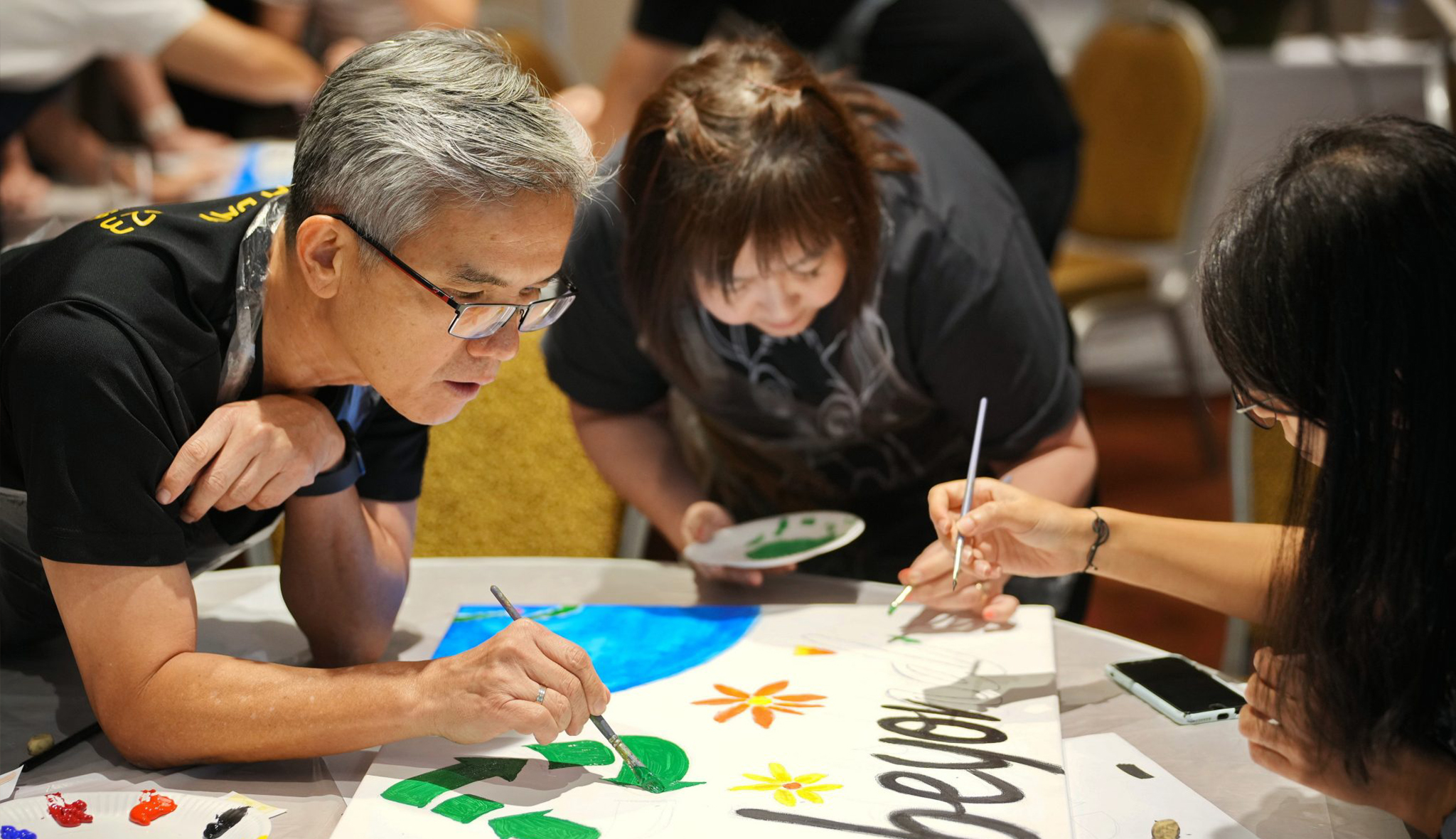
KINDNESS IN INK – HARMONY IN ART
KINDNESS IN INK – HARMONY IN ART About the Exhibition
























19 December to 21 December 2018
为了进一步贯彻落实十九大精神,复兴中华文化。此次活动是受新加坡、马来西亚方面邀请,一起建设三国文化艺术桥梁。在中国历史上,中新马三国的文化有着千丝万缕的联系和渊源,沿海居民的“下南洋”,和我们今天密切的文化交流,都见证了三国在文化上的认同和缘份。此次展览主要是为了响应中国提倡的一带一路国策,汇聚三个国家优秀的艺术家进行艺术交流,增进三国友谊,弘扬中国传统文化。
此次2018新时代·大美中国·第二届中新马书画名家作品展不仅展示中国艺术文化的深厚传统底蕴,也展示新时代中国艺术风貌和技法创新。同时也是在搭建一次东南亚的艺术盛宴。
This exhibition was put forth in order to further implement the spirit of the 19th National Congress for the revival of cChinese culture, The event was invited by Singapore and Malaysia to build a bridge of culture and art between the three countries. In the history of China, the cultures of China, Singapore and Malaysia have inextricably linked and origins. The exhibition is mainly to respond to China’s advocated One Belt and One Road National Policy, bringing together outstanding artists from three countries to carry out artistic exchanges, enhance the friendship between the three countries, and promote Chinese traditional culture.
The 2018 New Era, Damei China, and the 2nd Sino-Singapore Paintings and Calligraphy Exhibition not only showcases the profound traditional heritage of Chinese art and culture, but also showcases the new era of Chinese art and technological innovation.
快到新加坡视觉艺术中心观看这个展览吧!
Come on down to Visual Arts Centre to take a look at this exhibition!
Exhibition Dates/Time:
19 Dec 2018 – 21 Dec 2018 (10am – 8pm)
Opening Ceremony:
19 Dec 2018, 6pm
Guest of Honour:
Mr Stephen Leong Chun Hong
(President of the Federation of Arts Societies Singapore)
Honoured Guest:
Mr Choo Thiam Siew
This exhibition will display works from these 28 artists:
刘正刚, 马胜利, 宋伯军, 谭志宏, 徐宏毅, 沈春兰, 王 英, 占昌赣
张更生, 裴太平, 张朴野, 李德元, 王景明, 伍金结, 赵志锡, 李棣棠
苑同朝, 马吉昌, 柳尧福, 刘弼男, 杨钦竣, 张建民, 梁振康, 武雪丽
江石文, 林金海, Naphapon Phanist, 许佩瑶
Modparade Warehaus Sale Exhibition Modparade Warehaus Sale Exhibition Synopsis It’s
The 9th China·Singapore·Malaysia Calligraphy and Painting Works Exhibition Synopsis In

10 Penang Road,
#01-02 Dhoby Ghaut Green,
Singapore 238469
140 Paya Lebar Road,
#03-04 AZ@Paya Lebar Building,
Singapore 409015
6255 0711
info@visualartscentre.sg
62550711
67332155
Dhoby Ghaut Art Studio
Monday to Sunday: 11am – 8pm
Closed on Public Holidays, except by appointment.
MacPherson [Office & Storage]
By appointment only
Visual Arts Centre is an exhibition gallery and art studio at Dhoby Ghaut Green supported by the National Parks Board and the National Arts Council.
Since its initiation on 31 January 2016, the Visual Arts Centre Exhibition Gallery has hosted over two hundred international and local art and design exhibitions, boasting a diverse range of art styles and programmes.
Email:
info@visualartscentre.sg
Phone:
+65 6255 0711
+65 6733 2155
Featured Courses 推荐课程
Art Immersion 3 Medium Course 综合媒介绘画课
Drawing & Sketching Course 素描课程
Acrylic Painting Course 丙烯画课程
Watercolour Painting Course 水彩画课程
Oil Painting Course 油画课程
Chinese Ink Painting Course
Trial Sessions 试课
Chinese Calligraphy & Ink Painting
Graffiti Spray Painting Course
Portfolio Preparation Course (Process) 作品集 (DSA)
Portfolio Preparation Course (Process) 作品集 (Diploma)
Professional Manga Drawing & Digital Painting Course
Professional Interior Design & Freehand Rendering Course
Outdoor Urban Landscape Sketching Course
Private Art Classes
Creative Kids Art Immersion Course 儿童创意绘画课程
2025: Holiday Art Course for Kids & Teens 儿童和青年假期课程
2025 Kids (6-9YO) Holiday Art Course 儿童假期课程
2025 Teens (10-18YO) Holiday Art Course 青年假期课程
Team Building Art Jamming
Art Jamming Team Bonding Catalogue
Team Bonding
Gala Dinner Art Workshop
Batik Painting Workshop (Mural / Individual)
Graffiti Spray Painting on Canvas Workshop
Kids Birthday Party - Art Jamming
Kids T-Shirt Painting Art Party
Batik Painting Workshop
Graffiti Spray and Paint Workshop
Therapeutic Mental Health Workshops
Art Workshop
Workshops at SAM During SAW 2025
Digital Dreams - Transforming Ideas Into Art
Nude Life Drawing with Artist Guidance
Portrait Life Drawing with Artist Guidance
Chinese Ink Painting
Chinese Calligraphy & Ink Painting
Current & Upcoming Exhibitions
Venue Hire 场地出租
Hire of Visual Arts Centre Exhibition Gallery @ Dhoby Ghaut
Visual Arts Centre Exhibition Gallery @ Dhoby Ghaut
Visual Arts Centre Gallery and Studio @ MacPherson
Special Art Jamming Themes
Chinese New Year Art Jamming
Art Workshops for Singles and Dating
Women's Day
Labour's Day
National Day
Mid Autumn Festival
Deepavali Art Jamming
Halloween Art Jamming
Christmas Art Jamming
View More
Best Team Building Activity
Art Jamming Team Bonding Catalogue
零基础自助绘画(Art Jamming )工作坊
Kids Art Jamming Birthday Party Workshops
艺术生日派对-DIY粘土主题
Art Birthday Party With Diy Clay
Art Birthday Party With Tote Bag Painting 艺术生日派对-画托特包主题
Birthday Party With T-shirt Painting
艺术生日派对-画T恤衫主题
Art Competition and Affordable Art Fair Workshops
(Embracing Nature) Children and Youth Art Competition
Workshops & Fair Activities
Venue Hire
10 tips for a successful pop-up flea market event
Beautiful Space in the City Central
A Perfect Art Venue for Hire
What to consider when renting a venue for your fashion shows and pop-ups?
Art Course
Where to learn Professional Chinese calligraphy course in Singapore?
艺术疗愈如何让你心理更健康
Best Professional Art Courses In Singapore
在新加坡哪里能学专业素描/速写、油画、水彩、丙烯、水墨、艺术作品集准备、儿童美术、儿童青少年书法等专业美术绘画课?
在新加坡哪里学习专业书法课程?学习书法对儿童青少年的好处
View More
Art Portfolio Preparation - DSA (Kids)
凭什么,新加坡乌节路寸土寸金的商业宝地竟给国人当画室? 快!带你去看看!
Singapore Holiday 2025 - Learn Digital Landscape Painting and Manga Drawing
成人画画课就在视觉艺术中心
Applying into Art Schools - How does one build an art portfolio?
Others
Best Professional Manga Drawing Drawing Course in Singapore
对南洋画派新加坡第一代艺术先驱作品的印象
定制贵宾晚宴的艺术项目
Art Buzz: How to Appreciate Art?
《纪念刘抗诞辰111周年—刘抗书画遗作展》
10 Reasons to Learn Drawing and Sketching
View More
Art Therapy Course in Singapore!
Overseas Students Art & Cultural Exchange
Commissioning Custom made portraits/nude life by professional artists
FAQs for Art Portfolio Preparation - DSA, Diploma & Higher Education
In the Batik Introduction Handkerchief Painting workshop, participants will learn the traditional art of batik, a wax-resist dyeing technique originating from Indonesia. The workshop begins with a brief history and overview of batik, highlighting its cultural significance and various techniques. Participants will then observe a demonstration of applying wax with tjanting tools and dyeing the fabric. Following the demonstration, each participant will design and create their own batik handkerchief, applying wax to create patterns and then dyeing their fabric. The workshop concludes with a group discussion, allowing participants to share their creations and reflect on their learning experience.